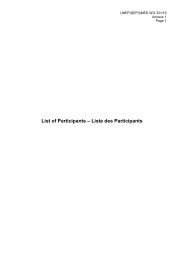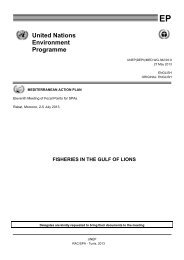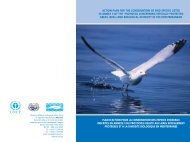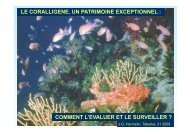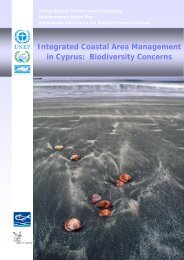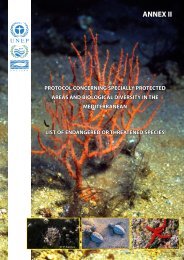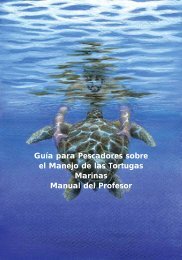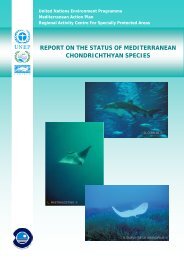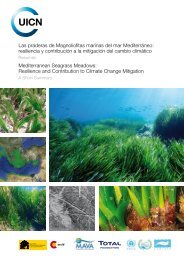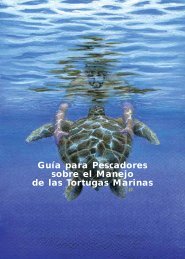Proceedings of the Second Mediterranean Symposium on Marine
Proceedings of the Second Mediterranean Symposium on Marine
Proceedings of the Second Mediterranean Symposium on Marine
You also want an ePaper? Increase the reach of your titles
YUMPU automatically turns print PDFs into web optimized ePapers that Google loves.
Williams<strong>on</strong> and Fitter, 1996; Piazzi et al. 2001; Boudouresque and Verlaque, 2002;<br />
Carlt<strong>on</strong>, 2002). Human disturbed habitats are <str<strong>on</strong>g>of</str<strong>on</strong>g>ten thought to be more susceptible to<br />
invasi<strong>on</strong>s (Ribera and Boudouresque, 1995; Ruiz et al., 1997; Leppäkoski et al., 2002).<br />
With reference to <str<strong>on</strong>g>the</str<strong>on</strong>g> <str<strong>on</strong>g>Mediterranean</str<strong>on</strong>g>, Boudouresque and Verlaque (2002) listed 84<br />
macroalgal species which have probably been introduced, 9 <str<strong>on</strong>g>of</str<strong>on</strong>g> <str<strong>on</strong>g>the</str<strong>on</strong>g>se are c<strong>on</strong>sidered<br />
invasive. Am<strong>on</strong>g <str<strong>on</strong>g>the</str<strong>on</strong>g>m <str<strong>on</strong>g>the</str<strong>on</strong>g> tropical green alga Caulerpa racemosa (Forsskål) J. Agardh<br />
has invaded in <str<strong>on</strong>g>the</str<strong>on</strong>g> last decade <str<strong>on</strong>g>the</str<strong>on</strong>g> western side <str<strong>on</strong>g>of</str<strong>on</strong>g> <str<strong>on</strong>g>the</str<strong>on</strong>g> <str<strong>on</strong>g>Mediterranean</str<strong>on</strong>g>, spreading <strong>on</strong><br />
every kind <str<strong>on</strong>g>of</str<strong>on</strong>g> substrate, from <str<strong>on</strong>g>the</str<strong>on</strong>g> surface to 60 m depth, and becoming a severe threat<br />
to algal diversity (Piazzi et al., 2001). Recently, C. racemosa was also observed for <str<strong>on</strong>g>the</str<strong>on</strong>g><br />
first time in <str<strong>on</strong>g>the</str<strong>on</strong>g> Gulf <str<strong>on</strong>g>of</str<strong>on</strong>g> Naples (Buia et al., 2001).<br />
About 2 000 000 <str<strong>on</strong>g>of</str<strong>on</strong>g> inhabitants live in <str<strong>on</strong>g>the</str<strong>on</strong>g> area <str<strong>on</strong>g>of</str<strong>on</strong>g> <str<strong>on</strong>g>the</str<strong>on</strong>g> Gulf <str<strong>on</strong>g>of</str<strong>on</strong>g> Naples (Italy, Sou<str<strong>on</strong>g>the</str<strong>on</strong>g>rn<br />
Tyrrhenian Sea); a wide urban area and a big commercial port, with a maritime traffic<br />
volume near to 36000 vessels per year (Flagella, pers. comm.), is present in <str<strong>on</strong>g>the</str<strong>on</strong>g> inner<br />
side <str<strong>on</strong>g>of</str<strong>on</strong>g> <str<strong>on</strong>g>the</str<strong>on</strong>g> gulf, and several fishing and touristic harbours, and aquaculture facilities are<br />
spread all around <str<strong>on</strong>g>the</str<strong>on</strong>g> coast. Such high density <str<strong>on</strong>g>of</str<strong>on</strong>g> populati<strong>on</strong> and c<strong>on</strong>sequent<br />
anthropogenic activities are able to determine str<strong>on</strong>g disturbances <strong>on</strong> marine ecosystems<br />
with possible changes in macroalgal communities.<br />
In <str<strong>on</strong>g>the</str<strong>on</strong>g> framework <str<strong>on</strong>g>of</str<strong>on</strong>g> <str<strong>on</strong>g>the</str<strong>on</strong>g> ALIENS project, a survey al<strong>on</strong>g Neapolitan coasts was performed,<br />
during <str<strong>on</strong>g>the</str<strong>on</strong>g> summer 2002, with <str<strong>on</strong>g>the</str<strong>on</strong>g> aim to detect <str<strong>on</strong>g>the</str<strong>on</strong>g> distributi<strong>on</strong> <str<strong>on</strong>g>of</str<strong>on</strong>g> C. racemosa, also<br />
providing a descripti<strong>on</strong> <str<strong>on</strong>g>of</str<strong>on</strong>g> <str<strong>on</strong>g>the</str<strong>on</strong>g> recipient communities, comparing habitats with a different<br />
degree <str<strong>on</strong>g>of</str<strong>on</strong>g> human interference. On <str<strong>on</strong>g>the</str<strong>on</strong>g> basis <str<strong>on</strong>g>of</str<strong>on</strong>g> macroalgal compositi<strong>on</strong>, differences am<strong>on</strong>g<br />
localities placed in human disturbed areas and localities far from possible source <str<strong>on</strong>g>of</str<strong>on</strong>g><br />
disturbance were descried. The occurrence <str<strong>on</strong>g>of</str<strong>on</strong>g> C. racemosa in many studied localities was<br />
discussed in relati<strong>on</strong> to species richness, total algal coverage and presence <str<strong>on</strong>g>of</str<strong>on</strong>g> main taxa.<br />
MATERIALS AND METHODS<br />
Study area and sampling design<br />
In July 2002 a hierarchical survey in <str<strong>on</strong>g>the</str<strong>on</strong>g> Gulf <str<strong>on</strong>g>of</str<strong>on</strong>g> Naples (Fig. 1) was performed <strong>on</strong><br />
subtidal rocky substrate at both 5 and 10 m depth. Sampling localities were selected <strong>on</strong><br />
<str<strong>on</strong>g>the</str<strong>on</strong>g> nor<str<strong>on</strong>g>the</str<strong>on</strong>g>rn and sou<str<strong>on</strong>g>the</str<strong>on</strong>g>rn sides <str<strong>on</strong>g>of</str<strong>on</strong>g> <str<strong>on</strong>g>the</str<strong>on</strong>g> Gulf ; <str<strong>on</strong>g>the</str<strong>on</strong>g> inner part was not c<strong>on</strong>sidered because<br />
<str<strong>on</strong>g>of</str<strong>on</strong>g> its sandy and muddy bottoms. Six “impacted” localities (named from 1 to 6) were a<br />
priori selected in human disturbed areas (close to farming facilities, harbours and urban<br />
z<strong>on</strong>es), six (from 7 to 12) were chosen in relatively undisturbed areas: <str<strong>on</strong>g>the</str<strong>on</strong>g>y were<br />
c<strong>on</strong>sidered as “c<strong>on</strong>trols”. Each locality comprised a stretch <str<strong>on</strong>g>of</str<strong>on</strong>g> shoreline <str<strong>on</strong>g>of</str<strong>on</strong>g> about 0.2 - 1.5<br />
Km and included three sites, 15 m l<strong>on</strong>g, randomly selected; at each site three random<br />
quadrats (50 x 50 cm <strong>on</strong> sub-horiz<strong>on</strong>tal substrate at both depths) were examined by<br />
visual estimati<strong>on</strong> <str<strong>on</strong>g>of</str<strong>on</strong>g> <str<strong>on</strong>g>the</str<strong>on</strong>g> coverage <str<strong>on</strong>g>of</str<strong>on</strong>g> c<strong>on</strong>spicuous macroalgal species (more than 2 cm in<br />
size or smaller, but forming patches occupying more than 4 square cm); species not<br />
recognised in field were collected and fixed in formol 4% to be identified in laboratory.<br />
Species richness (number <str<strong>on</strong>g>of</str<strong>on</strong>g> taxa) and total percent coverage were calculated for each<br />
<str<strong>on</strong>g>of</str<strong>on</strong>g> <str<strong>on</strong>g>the</str<strong>on</strong>g> studied quadrats.(Fig.1)<br />
ACTES DU DEUXIEME SYMPOSIUM MEDITERRANEEN SUR LA VEGETATION MARINE (ATHENES, 12-13 DECEMBRE 2003)<br />
169



